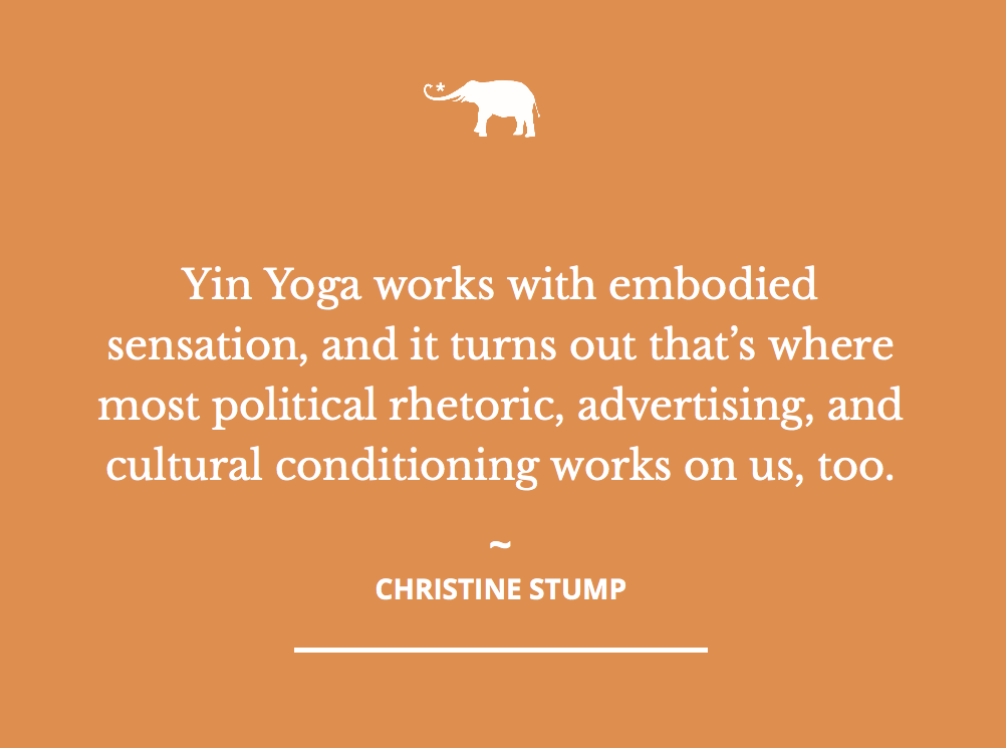
Yin yoga has three simple principles or Tattvas that we can also use for creative engagement when we already feel safe in everyday life.
1. Find an edge of sensation you want to explore.
2. Cultivate stillness in body, mind, or both.
3. Remain for a time.
I would add a fourth: pause in a neutral position to feel the integration.
Rather than steering clear of feeling the edge, we steer into it. An edge is discomfort of some kind: tightness, tension, rigidity, stuckness, nothingness.
It can dissolve into burning or sweetness only to emerge as a different expression of force. Exploring discomfort means staying open to things being different, becoming what they weren’t or what we couldn’t see.
You find new edges in Yin by melting—not by pushing. This procedure runs counter to most of our unconscious habits in just about every way.
Yin Yoga is a Goldilocks practice: not too little, not too much.
Two minutes once a month isn’t likely to do much. Two minutes once a day will, with time. Two minutes with rest before three minutes and more integration, before two minutes with rest, repeated regularly changes how we live.
This practice makes it more and more likely we will meet difference, challenge, and discomfort with equanimity.
Working with discomfort in our bodies is a laboratory for our discomfort with people who believe or act differently from us.
The immovable lines that seem to divide us socially and politically are constructions (habits) that we feel in our bodies. Habits of thought and movement alike create lines of tension and rigidity (as well as laxness) in our bodies.
When we are confronted with whomever the other is for us, the sensations arising from these habits can prevent us from being creative with these others.
Yin yoga works with embodied sensation, and it turns out that’s where most political rhetoric, advertising, and cultural conditioning works on us, too. Of course, all yoga works with embodied sensation. Yin yoga focuses clearly on sensations of discomfort, or even ones we label as pain.
It is also a training ground for bringing into awareness, softening, and organically releasing—slowly, over time—deeply held tensions. The habit of releasing layers and layers of habit translates into everyday life. Obstacles to freedom are dissolved, and our original selves are freed to shine through. From here, we can build a society of creative activity based on valuing the dear neighbor—without distinction.
How to distinguish discomfort from pain?
Approach slowly, with the intention to stop, back up, and acknowledge any sensation that is too much. Pain in the body is often sharp or electric, and it means something is about to be or already being damaged. Discomfort means you’re feeling forces you aren’t used to or usually move away from.
Setting aside time to discern the difference and explore sensations that we can’t slow down to listen to in everyday life is absolutely crucial to healing. Feeling is one of the most powerful ways we dissolve the obstacles to healing or Kleshas.
Setting aside time means finding or creating a place and window of safety, a prerequisite for this work. Living in a society where this opportunity is not equally available to all is one of the pains we all live with, one that many of us are shielded from feeling.
In our popular culture, mastery is often conceptualized as having built strong habits, but what if the most important habit is the habit of feeling newness, the stuckness, the rigidity, the tightness, the compression, and doing nothing more until it changes of its own accord?
Doing nothing to change it, only being with it; not pushing, not pulling, not salving, not telling stories. What if the most important habit is the habit of dissolving habits?
Finding stillness is challenging in the midst of beauty and pleasure and plenty. Courting stillness in the midst of discomfort cuts against the grain of every survival instinct celebrated in popular culture. We are encouraged to find the fix, try the next new thing, listen to an expert, and take the cure. What if the cure is sitting with the thing we’re trying to disappear?
Remain for a time in the cauldron of discomfort without stirring the pot, consciously, by choice.
The wonder of this is that discomfort brings changes into awareness.
But the way must be prepared: discomfort is not pain, it is not a threat, and it is not damage. We have blurred the line between discomfort and pain in our common parlance.
Those of us with the most comfort have gotten comfortable having opinions about what people with remarkably less comfort should endure. And people with the most discomfort and pain have so little respite that it all blurs, and the blur becomes the atmosphere.
In Yin yoga, we are learning how to work with the structure of the body, the fascia, to release ways it ossifies, gets stuck, adheres, or becomes less nimble.
Fascia is an expression of the extracellular matrix (ECM), the stuff around the stuff we were taught to think of as scaffold and pulleys, or the bones and muscle. The ECM is state-dependent, like a cornstarch slurry: solid under pressure, liquid when approached gently. That solid state can get stuck though. No amount of pushing makes it soften.
Only witness and gentleness can release it. Yin yoga doesn’t replace the Yang ways of exploring body shapes, but it is just as necessary.
The same is true of social relationships and structures: they are the matrix of culture.
We’ve been taught to focus on beliefs and symbols when the reality is in the relationships—in what we cannot see but can and do feel. And what we feel we internalize if we don’t metabolize. The most available responses to social tension are the same as to physical pain: to push, pull, run, spin, bear down, rub some dirt in it, or put our nose to the grindstone.
This may help us to live and see another day. It will not help make us safer, happier, more prosperous, or more ourselves.
What matters is the relationships between us.
Until we can acknowledge an edge in our personal relationships—to people, ideas, articles, movements, parties, or stances—and feel that as discomfort rather than righteousness, defensiveness, attachment, or aversion (unknowing replacing what seems obvious), we won’t be in possession of the only force that can change the structures of our lives.
Stillness creates the space to witness what we didn’t see before, remaining with what seems foreign in humility.
Yin yoga is much harder where there is true pain, damage, or threat. It may only be possible to apply under these conditions if you’ve worked with it under conditions of safety and small discomforts, and it’s far better to get away from damage or threat if you can.
This means that those of us who live with a bare minimum of damage or threat of damage in our lives have work to do to meet the edges of our own discomfort with enough patience, enough care, and enough time to loosen up the matrix of belief and reaction so we can create a society where this circumstance is common to all—without distinction.
~
Serving and loving the dear neighbor without distinction is the core value of the Sisters of St. Joseph of Carondelet, who were central to my early education.










Read 4 comments and reply